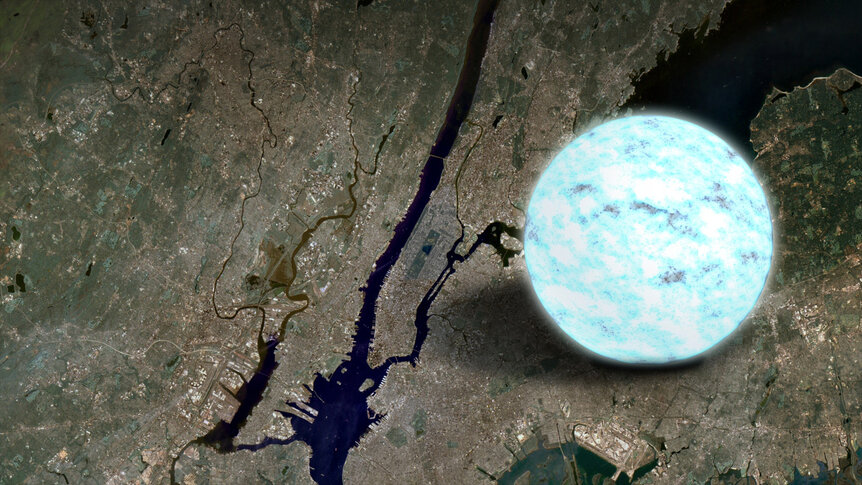Create a free profile to get unlimited access to exclusive videos, sweepstakes, and more!
Vela X-1 is plowing its way through the galaxy

Every now and again you run into an astronomical object where everything about it is mind-blowing. And I get to share it with you! Let me introduce you to a binary star that will crush your imagination and make you realize the Universe is way cooler than you knew.
A few million years ago, and 6,000 light-years from Earth, two stars were born out of the gas and dust in the galaxy in a cluster with many other stars. These two formed together, so close their mutual and growing gravity bound them together, forcing them to orbit one another. And they grew huge: By the time they switched on and became true stars, they each had more than two dozen times the mass of the Sun.
They were monsters. Huge, hot, and incredibly luminous, each blasting out as much as 100,000 times as much energy as the Sun does. Replace the Sun with one of these beasts and the Earth would evaporate like an ice cube on a scorching hot skillet.
Stars like this don’t live long. After a few million years, one of them (which had slightly more mass to begin with) swelled into a red supergiant, dumped huge amounts of material onto the other star, and then exploded. The two stars were so close together they orbited each other rapidly, taking just a few days to swing each other around. Because of this the explosion was asymmetric, giving the system a huge kick. Still bound by their gravity, this acted like a rocket thrust, flinging the binary out of its cluster at high speed into interstellar space.
The star that exploded was now a neutron star, an incredibly dense ball of subatomic particles that is the remnant of the core of the star. It squeezes nearly twice as much mass as the Sun into a sphere just a few kilometers across! The gravity and magnetic fields of such an object are so intense that any material that falls on it slams into the surface at an appreciable fraction of the speed of light, and the complicated physics of the environment responds by emitting a brilliant glow of X-rays.
Today, a few million years later, we see this binary as Vela X-1, the first X-ray source seen in the constellation of Vela. We call this a high-mass X-ray binary, or HMXB, because the “normal” star — the one that has not yet exploded, a blue supergiant called HD77581— is such a massive star (low-mass X-ray binaries are different, with a neutron star or black hole orbited by a much lighter star, one more like the Sun).
In physical space, this binary system is still located in the plane of the galaxy, which is choked with gas and dust. Because of that high-speed kick given when the primary star exploded, Vela X-1 is screaming through this material at over 300,000 kilometers per hour. What does that look like?
I can show you. Amateur astronomer Rolf Olsen has taken a dramatic and phenomenally lovely image of it:
Whoa. This image was taken in early 2018 using his home-built (!) 32 cm telescope, and is a total of seven hours of exposure time. He used four filters: a red, green, and blue combination to create a “natural” color image, plus one that preferentially lets through light emitted by warm hydrogen gas (also colored red).
You can see that gas in the image, and the Vela X-1 system is the brightest star in field as well. The neutron star itself is invisible, so all the light you see is from HD77581, the blue supergiant companion star.
But take another look: See that arc of material just above Vela X-1? That is literally gas being pushed out of its way as it barrels through the galaxy! HD77581 is emitting a wind of particles, called a stellar wind (like the solar wind). Because that star is massive and bright, the wind is fierce, and when it slams into the gas between the stars in the galaxy it creates a vast arc called a bow shock. “Bow” because it’s like water being pushed off the bow of a ship, and “shock” because the wind slams into that material faster than the speed of sound in the gas, creating a shock wave.
The result is that graceful arc. Mind you, it’s several light-years long. These two stars are affecting their environment on a huge scale, interacting with material across tens of trillions of kilometers!
Another thing about this I find fascinating. This arc was discovered in 1996, using a 1.5-meter telescope on the suspicion that Vela X-1 might be a runaway star. And now just a couple of decades later an “amateur” astronomer* can fairly easily image it.
Not only that, we see many more examples of these bow shocks, including one caused by Betelgeuse and another by the bruiser of a star Zeta Ophicuhi (and which happens to be the subject of what is among my favorite astronomical images of all time).
One of the things I find so fascinating about science, and specifically astronomy, is how such violence and violent objects can produce such beauty. As long as this beauty is seen from a long, long way away.
* There’s no real definition of this term, and is used as a catchall for someone who isn’t necessarily a professional astronomer. It sometimes implies someone who isn’t as well trained, which is generally unfair and obviously not true in Olsen’s case.




























